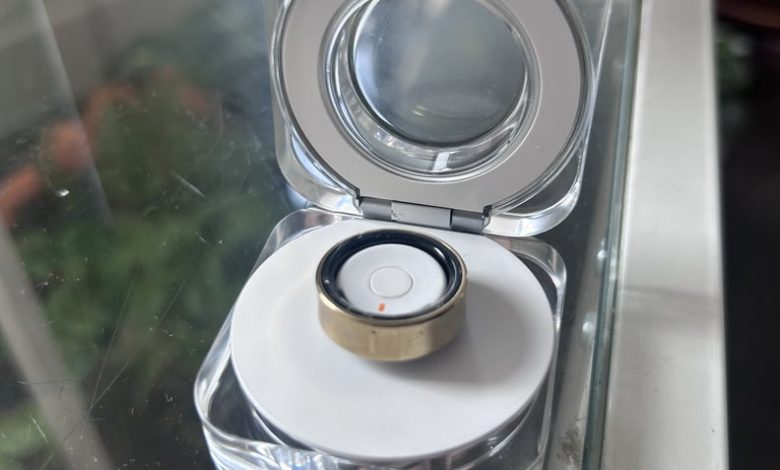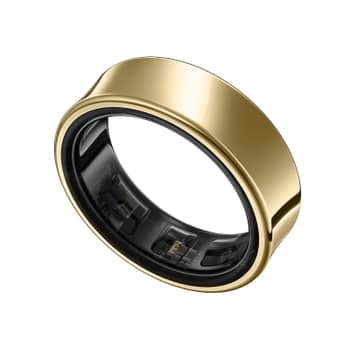I Wore the New Samsung Galaxy Ring For a Month. Here’s How It Went.

I am a lion. I’m not trying to brag but . . . actually maybe I am. Samsung Health classified me as such after a week of wearing their shiny new Samsung Galaxy Ring ($399) to bed. As the app’s AI tool tells me, lions “have healthy sleep patterns, sleeping at consistent times, getting enough sleep, and sleeping deeply.” They’re truly well-rested kings (of the jungle) and evidently so am I.


The new Galaxy Ring, Samsung’s first foray into the world of ring health tracking tech and the first major competitive player in this space since the popular Oura Ring came out, hit the market in July 2024. The brand sent me a loaner ring to try out myself for a month, and while my lion status was probably my favorite thing I learned about myself while I was testing the ring, I made a few other notable discoveries about my health along the way. Here’s how it went.
What I Like About the Samsung Galaxy Ring
First and foremost: she’s chic! Although smartwatch tech has been booming for a while now, there aren’t a ton of ring options, and I found the Galaxy Ring to be a game-changer for more formal occasions. As someone who enjoys tracking my health 24/7, I can’t tell you how many times I’ve stashed my smartwatch in my going-out purse at the last minute, or had someone hold it while I took a picture. I love the thing, but it’s not always the fashion statement I want to make.
A ring, on the other hand, is much more discreet. Samsung’s option is a similar size to the Oura ring, but has a subtly concave design that I think makes it look less bulky (and therefore more inconspicuous). It also comes in multiple colorways (matte black, gold, and silver) so you can match it with your regular jewelry (unless you’re a rose gold girlie, for now). You could even stack it with other fashion rings.
I found the ring to be comfortable, especially while sleeping in it (something I’ve never been able to get used to with a smartwatch), although I did wake up with red marks on my finger a few times after wearing it overnight.
In terms of functionality, I was shocked at how long the battery lasts. I’m used to charging my smartwatch every night before bed just to make sure that I don’t run out of battery while on a run. But the fact that it lasts about a full week on its own felt life-changing. It meant I could wear it to bed and track my sleep consistently, something I hadn’t been able to do before.
Which brings me to the sleep tracking, which I loved. It was interesting to see my “sleep score” and get personalized AI sleep coaching tips. I also enjoyed the data I got on the time I spent in different sleep stages, though it wasn’t markedly different from other smart fitness stats on this.
That said, it’s possible I dug the sleep features because I love being complimented, and the Galaxy Ring designated me as a “lion” or “level 4” sleeper, the highest level. If I had tried the ring at a busier period (e.g., not on my summer vacation), I might have ended up being lumped in with other animals, such as the penguins (who “remain alert and watchful even when they sleep”), moles (who “avoid sunlight” and “wake up too often”), alligators (who “hunt at night”), or — heaven forbid — a shark, the lowest level in the Samsung animal sleep hierarchy (they “never stop moving”).
Another feature I enjoyed was the Galaxy Ring’s stress level tracking. You can see the peaks and valleys of stress throughout the day, which seemed to pretty much perfectly align with when I was up against a deadline or in a crowded grocery store line. And finally, I liked that the Galaxy Ring automatically tracked my runs and walks without me needing to manually start or stop a workout. I think the distance and time measurements were slightly less accurate than my smartwatch tracking, but it was nice to not have to think about pressing start.
What to Consider Before Trying the Samsung Galaxy Ring
The Samsung Galaxy Ring’s app gives you a daily “energy score” based on a variety of factors from the previous day, including sleep and activity, and will offer up related AI-informed health tips. For the most part, the advice was fine, but some of the messaging felt contradictory. For instance, on a few days I felt I’d been pretty active, the app’s AI suggested I increase my moderate-to-vigorous exercise time. After a day I didn’t feel I did more activity than usual, the app told me to cool it with the exercise, calling my active time “excessive.” It felt like I couldn’t win.
Additionally, as someone who uses a health tracker largely as a fitness tracker, I found the Samsung Galaxy Ring’s options for workout logging to be very limited, especially when compared to the huge library offered by the Apple Watch. The Galaxy Ring lets you log running, hiking, swimming, and biking, but a lot of workouts would need to fall under “other workout” and the only strength training option is “weight machines” (I’m more of a dumbbell person).
Finally, one of the biggest things to consider about the Galaxy Ring: it doesn’t work with non-Android phones, and it works best with specifically Samsung-version Androids (without a Samsung with Galaxy AI, smart features like the “energy score” can’t work). This means iPhone girlies (guilty) would have to make a very big switch (RIP blue text bubbles) to enjoy the Galaxy Ring, or wait and hope the tracker becomes compatible with iPhones before too long.
Who the Samsung Galaxy Ring Is Best For
If you’ve bought into the fitness tracker madness like me, you’ll love the Galaxy Ring. It delivers a ton of data and feels like a truly holistic health tracker, as it gives insights into your sleep and stress as well as your fitness. That said, if you’re looking for a deep dive into your fitness habits, you may prefer a watch with a screen that lets you see workout metrics in real time, or with more workout options to log. If too much health data makes you anxious, or you have a history of disordered eating or exercise habits, a tracker like this may not be for you.
Is the Samsung Galaxy Ring Worth the Splurge?
The Galaxy Ring is $399, right in line with the aluminum Apple Watch Series 9 and a little more expensive than the starting price for the Oura Ring (which is $299, but you also have to pay a membership of $70 annually for their app, which could offset this cost eventually). Whether or not that price is worth it to you depends on what you’re looking for out of your tracker. If it’s sleep, stress, and fitness data, and you’re already a Samsung user, that might be worth it for you.
Additional Details About the Samsung Galaxy Ring
- The Samsung Galaxy Ring comes in three colors: titanium silver, titanium gold, and titanium black.
- It comes in nine sizes, from US 5 to 13, and you can order a free sizing kit to find your perfect size.
- It’s 7 millimeters wide, 2.6 mm thick, and it weighs from 2.3 to 3.2 grams depending on the size.
Where Is the Samsung Galaxy Ring Available?
The Samsung Galaxy Ring is available on Samsung.com or BestBuy.com.
Rating
Molly Longman is a freelance journalist who loves to tell stories at the intersection of health and politics.




